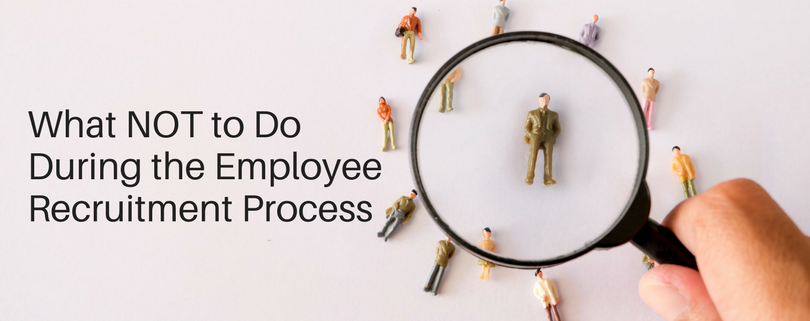What NOT To Do During the Employee Recruitment Process
Recruiting quality talent is a fine art. And when companies don’t hire quality talent, they lose big time. The cost of recruiting, hiring and onboarding an employee can cost up to $240,000 according to Jörgen Sundberg, CEO of Link Humans, an employer branding agency in London. And, The U.S. Department of Labor says the price of a bad hire is at least 30 percent of the employee’s first-year earnings.
There are various things hiring managers can both do and avoid doing in effort to recruit long-lasting employees. Here are five mistakes to avoid during the employee recruitment process:
- Not strategically sourcing your talent. It all starts with the first step of the process: sourcing talent. It’s important to consider a variety of sources while looking to fill a position, but be careful not to swing the hypothetical door open so widely that you have to filter through too many unqualified applications. It’s all about the happy medium.
- Not considering candidates of diverse backgrounds. People with diverse backgrounds hold unique experiences and skills valuable to the workplace. Some hiring managers can make the mistake of only hiring candidates who are similar to themselves, intentional or not. It’s important to focus on hiring a wide variety of talent regardless of gender, race, ethnicity, age, sexual orientation, personality, ways of thinking etc. Not only is this frowned upon, but also illegal in some circumstances.
- Rushing to fill the position quickly. While it’s important to fill positions with a sense of urgency, rushing to find someone qualified enough as quickly as possible can cause you to overlook a great candidate or two. Take some time to understand the applicant before deciding if he/she is the right candidate for the job. This can include looking beyond their resume to figure out if they’re the right fit.
- Not focusing on the candidate’s motivations. Your ultimate goal is to get that position filled, but consider finding the right job for the candidate during a face-to-face interview vs. finding the right candidate for the job. Humanize the candidate and try to understand why they are sitting in that interview chair in the first place. Once you understand the candidate’s motivations for leaving the position they’re currently at, it will better help you determine if they will be a good fit with your company culture and the job in question.
- Failing to contact rejected candidates. One of the biggest gripes that job seekers have is the hiring manager failing to communicate to them that they didn’t get the job. This can hurt your company’s reputation – not only from a recruiting standpoint but also from a general business standpoint. Let rejected candidates know they didn’t get the job and why, and in a timely manner. Doing so can also soften the blow and not leave such a bad taste in their mouth.
Sources:
Jobvite
Entrepreneur
SHRM
Want to learn more about our recruiting solutions? Let’s talk!





